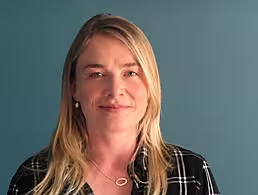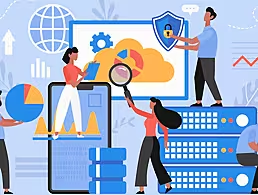Secondmind’s Sarah Jarvis discusses her passion for machine learning and data science and why communication is one of the key skills in this area.
Sarah Jarvis is the director of applied machine learning engineering and data science at AI company Secondmind. Her role involves looking at how data science fits in with machine learning across the company and how it can be applied to real-world settings.
“I started out as an undergrad in computer engineering before doing a PhD in computational neuroscience, where I was simulating complex networks to understand how to best interact with the brain,” she told Siliconrepublic.com.
“It turns out that in doing so, I was learning a lot of the skills I needed for data science: the ability to use data to identify trends in complex systems and how to interact with such systems to get the biggest impact.”
Jarvis said that while she never had a specific moment where she realised she wanted to be a data scientist, she said it became a natural progression based on her interest in using insights to solve real-world problems.
“It was always in my nature to ask lots of questions. And for me, that’s what data science is all about: asking interesting questions based on the data you have – or often the data you don’t have.”
‘How do you get around data that is known by the human but not represented in digital form?’
– SARAH JARVIS
But one of the things she underestimated early on in her career was the importance of good communication skills in this sector. “Data science is so multi-disciplinary that you have to be comfortable talking to people outside of their, and often your own, comfort zones,” she added.
“When I was leaving academia for industry, I didn’t appreciate how important my communication skills were for landing and excelling in certain roles. Knowing what I know now, I would have put more weight on these skills and gone for more challenging roles earlier than I did. And quite often, it comes back to asking questions – a common theme in data science.”
The future of data science
Jarvis said one of the key trends in data science at the moment has arisen as a result of the pandemic. “Covid-19 has exposed a lot of limitations with historic data when it comes to predicting what to do next. This has led to lots of questions about the need to capture human knowledge and experience into AI systems. It’s an interesting challenge because human and machine learning systems are fundamentally different in terms of how they view the world,” she said.
“I think it’s particularly pertinent for a data scientist: how do you get around data that is known by the human but not represented in digital form?”
Another trend that Jarvis said is already underway is about how to move from a forecast to a decision. This is already happening in specific cases within machine learning and AI, such as with self-driving cars.
“I believe the interplay between these two trends offers a lot more nuance than the two extremes that we currently have, which seems to be either forecasts or full automation,” said Jarvis.
“Correspondingly, it’s going to be vital to have clear data science approaches to know that we’re applying the right techniques to have the best impact. The stakes are high, as getting this right will allow people to collaborate with AI through blending the strengths of both. I see this as being critical if AI is going to function effectively: both in smooth driving conditions as well as dynamic, uncertain environments.”
While we have focused on providing information about different careers in data science on Siliconrepublic.com this week, Jarvis believes the data community needs to get better at defining what exactly data science is.
“The definition of a data scientist is nebulous and because we often can’t really explain what it is, it can be difficult to determine where a business analyst ends and a data scientist begins,” she said. “The result is data scientists are spread thinly over a huge remits, impacting the effectiveness of our work.”
She added that there is a “clear mismatch” between how the data science community views its role and industry’s understanding of what constitutes data science. “The people who often benefit the most from data science – business development – often don’t have the knowledge to define exactly what they need.
“For data science to fulfil its potential and data scientists to be more valued, we need to have an open conversation about this within our community, as well as educating the wider business community. I see that this is happening, but there’s still a way to go.”
Advice for data scientists
For those who are interested in pursuing a career in data science, Jarvis said listening and questioning constantly is key. “Not just in relation to the signals in the data, but listen and question the people around you – your colleagues, the wider business, your customers, the systems you’re working with. You can be technically gifted, but if you’re not prepared to dig into what’s going on and be curious, you’ll struggle.”
She also advised building a comprehensive data science toolbox. “There’s no manual that says, ‘Read this and you can do data science’. The more interesting a collection of tools that you build up, the better position you put yourself in to tackle the wide variety of challenges that will be thrown at you.”
On the productivity side, Jarvis said a great tip from a colleague was to block out time in your diary to do things. “This means I can focus on projects without distractions, whilst also giving myself a useful indication of when I’ve got too much on my plate,” she said.
“Working from home has thrown up interesting productivity challenges. One thing that works for me is to change my working style from time to time. For example, if there’s a talk I want to listen to, I’ll move out of my home office and go sit in the garden or dining room. The change of scene freshens things up and puts me in a different mindset, while also removing me from the distractions of Slack and email.”
Finally, she advised making some time at the end of the week to make a ‘hero list’ of what went well. “I follow this by noting down my priorities for the week ahead, which sometimes includes any questions that I didn’t already get to answer. It helps to close the week on a positive note, whilst giving me a clear focus when Monday morning comes around again.”
Want stories like this and more direct to your inbox? Sign up for Tech Trends, Silicon Republic’s weekly digest of need-to-know tech news.




